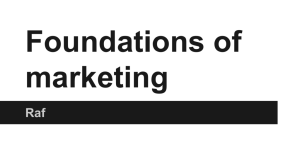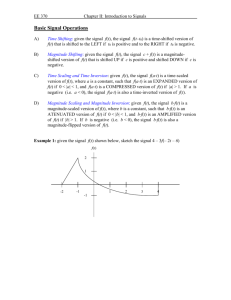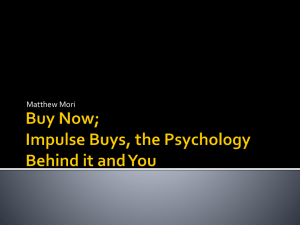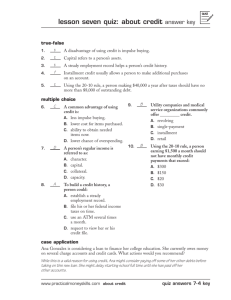The Effects of Information Searching and Information
advertisement
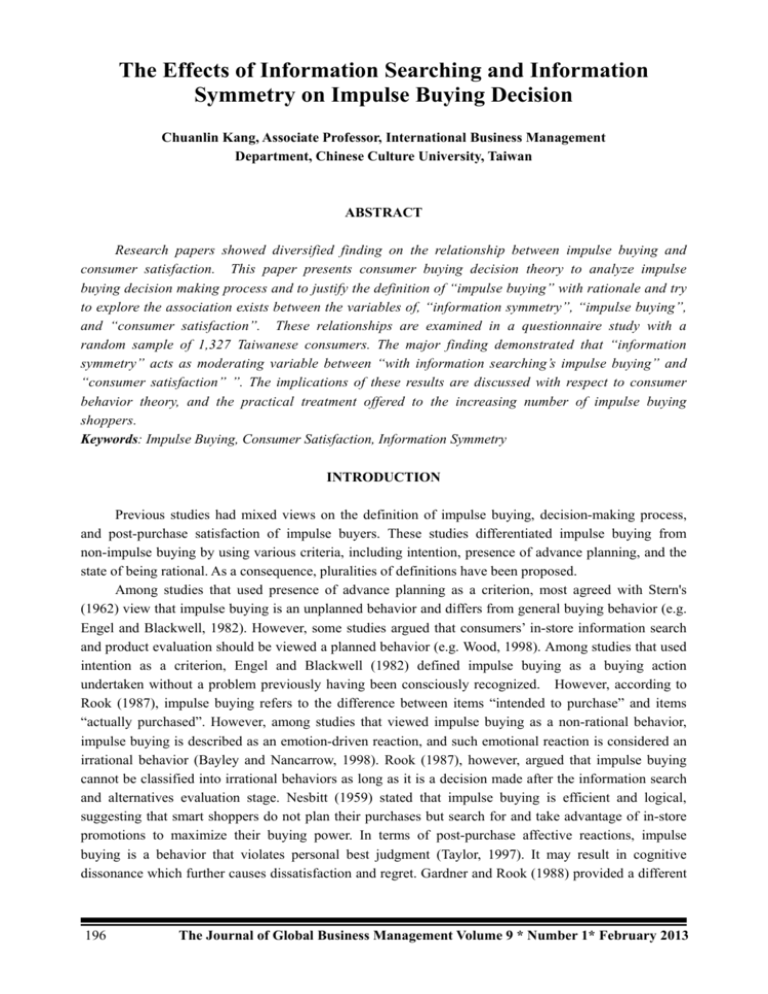
The Effects of Information Searching and Information Symmetry on Impulse Buying Decision Chuanlin Kang, Associate Professor, International Business Management Department, Chinese Culture University, Taiwan ABSTRACT Research papers showed diversified finding on the relationship between impulse buying and consumer satisfaction. This paper presents consumer buying decision theory to analyze impulse buying decision making process and to justify the definition of “impulse buying” with rationale and try to explore the association exists between the variables of, “information symmetry”, “impulse buying”, and “consumer satisfaction”. These relationships are examined in a questionnaire study with a random sample of 1,327 Taiwanese consumers. The major finding demonstrated that “information symmetry” acts as moderating variable between “with information searching’s impulse buying” and “consumer satisfaction” ”. The implications of these results are discussed with respect to consumer behavior theory, and the practical treatment offered to the increasing number of impulse buying shoppers. Keywords: Impulse Buying, Consumer Satisfaction, Information Symmetry INTRODUCTION Previous studies had mixed views on the definition of impulse buying, decision-making process, and post-purchase satisfaction of impulse buyers. These studies differentiated impulse buying from non-impulse buying by using various criteria, including intention, presence of advance planning, and the state of being rational. As a consequence, pluralities of definitions have been proposed. Among studies that used presence of advance planning as a criterion, most agreed with Stern's (1962) view that impulse buying is an unplanned behavior and differs from general buying behavior (e.g. Engel and Blackwell, 1982). However, some studies argued that consumers’ in-store information search and product evaluation should be viewed a planned behavior (e.g. Wood, 1998). Among studies that used intention as a criterion, Engel and Blackwell (1982) defined impulse buying as a buying action undertaken without a problem previously having been consciously recognized. However, according to Rook (1987), impulse buying refers to the difference between items “intended to purchase” and items “actually purchased”. However, among studies that viewed impulse buying as a non-rational behavior, impulse buying is described as an emotion-driven reaction, and such emotional reaction is considered an irrational behavior (Bayley and Nancarrow, 1998). Rook (1987), however, argued that impulse buying cannot be classified into irrational behaviors as long as it is a decision made after the information search and alternatives evaluation stage. Nesbitt (1959) stated that impulse buying is efficient and logical, suggesting that smart shoppers do not plan their purchases but search for and take advantage of in-store promotions to maximize their buying power. In terms of post-purchase affective reactions, impulse buying is a behavior that violates personal best judgment (Taylor, 1997). It may result in cognitive dissonance which further causes dissatisfaction and regret. Gardner and Rook (1988) provided a different 196 The Journal of Global Business Management Volume 9 * Number 1* February 2013 view. Their empirical evidence suggests that most impulse buyers feel good and do not have significant dissatisfaction after purchase. Wood (1998) also stated that impulse buying is usually accompanied with feelings of pleasure and excitement. Considering the diversity of views about impulse buying, this paper will employ the consumer decision-making theory and the Engel, Kollat, and Blackwell model (E-K-B model) to analyze impulse buying decisions. This paper proposed that the buying decision of impulse buyers is characterized by being unplanned prior to purchase, probably accompanied by information search and alternatives evaluation, and short decision-making time. As to post-purchase satisfaction, this paper proposes that in consumers’ information search process, information symmetry may have a moderating effect. THEORETIC FOUNDATION AND HYPOTHESES DEVELOPMENT Decision-making process of impulse buying Engel, Kollat, and Blackwell (1982) proposed a theoretical model of consumer decision-making. This model, commonly known as E-K-B model, divides consumer decision process into five stages, including problem awareness, information search, and evaluation of alternatives, purchase, and outcome. The need for impulse buying is induced by certain external stimuli and is not consciously recognized before purchase (Crawford and Melewar, 2003). Impulse buying in the “problem awareness” stage is characterized by “being unexpected prior to purchase”. As to the information search stage, previous research has shown that impulse buying is a decision that is not always made after information search and evaluation of alternatives. Consumers who skip these two stages are not concerned about the attributes and conditions of the product they purchase. They purchase the product simply to meet certain affective needs (Mowen and Minor, 1998). However, some impulse buying actions are undertaken after information search and evaluation of alternatives but based on lower standards (Hirschman, 1992). Therefore, impulse buying can be divided by whether it is a decision made after these two stages into two kinds. In these two stages, impulse buying is characterized by “being unnecessary at the moment”. If it were necessary, consumers would perform information search earlier, not at the last minute before purchase (Nesbitt, 1959) and might not have strong feelings of being surprised or excited (Stern, 1962). The purchase stage refers to a stage where consumers choose only one item among a number of alternatives based on their needs. Previous research has indicated that with the evolution of the shopping environment, practical economic benefit is no longer the sole factor considered by consumers (Dittmar, Beattie, and Friese, 1996). Consumers express their self-identity on the items they purchase (Gainesville, 2002). Impulse buyers proceed from the first stage to the purchase stage in a very short time. Thus, the third characteristic of impulse buying is “short decision-making time”. The outcome stage is where feelings of satisfaction or dissonance emerge. It has been documented that satisfaction or dissonance occurs in both impulse purchases and planned purchases, and both may affect post-purchase evaluations (Oliver, 1977). To sum up, the buying decision of impulse buyers is characterized by being unplanned prior to purchase, probably accompanied by information search and alternatives evaluation, and short decision-making time. Therefore, this paper proposes to classify impulse buyers into two kinds. The first kind of impulse buyers makes the decision without information search. Their buying behavior is intended to satisfy certain affective needs. The second kind makes the decision after information search. Their buying decision is made on impulse but through all the decision-making stages to maximize the benefits of the purchase. The Journal of Global Business Management Volume 9 * Number 1 * February 2013 197 Consumer satisfaction Consumers who perform information search before making a buying decision can be inferred that they pay more attention to the utility of the product they purchase. The more effort they put on information search, the smaller the difference between expectations and actual perceptions can be. In contrast, consumers who make a buying decision without information search seem to be more concerned about whether they can feel satisfied after the purchase. Their post-purchase perception is more focused on immediate affective responses to the decision. Even if there is any dissonance, they will adjust their cognitions to resolve the internal conflict (Mowen and Minor, 1998). Consumers whose impulse buying decision is made after the information search stage may have probably lowered their standards in evaluating the product’s attributes (Hirschman, 1992). H1: In the impulse buying context, information search has a significant and positive effect on post-purpose satisfaction. Impulse buying and post-purchase satisfaction are not related if the decision is made without information search. Information symmetry Shiv and Fedorikhin (1999) pointed out that the effects of product attributes on impulse buying are moderated by the content of information available to consumers. Consumers’ information processing ability is limited by the symmetry of information. If their information processing ability or the information symmetry is low, they tend to make an affective decision; if otherwise, they can have a better control of their impulse and make a rational decision. According to Kulkarni (2000), in a high information asymmetry context, consumers are usually unable to know the quality of a product until practical use despite a lengthy information search. A gap between expected and actual performance may arise as a result. The smaller the information asymmetry is, the less likely that the actual performance is to deviate from the expected performance, because the expected performance derives from rational thinking. After sufficient information search, impulse buyers tend to make more rational decisions and have expectations that are closer to actual performance as long as their information processing ability or the product information symmetry is high. Besides, impulse buyers will typically reduce their cognitive evaluation of product attributes (Weinberg and Gottwald, 1982), so they tend to have smaller dissonance between expected and actual performance of a purchased product. H2: In an impulse purchase made after information search, information symmetry has a significant impact on post purchase satisfaction. H3: Information symmetry has a moderating effect on the relationship between information search and post purchase satisfaction. RESEARCH DESIGN The definition and measurement of each variable are explained as follows: Impulse buying As previously discussed, impulse buying has three characteristics, including “unplanned prior to purchase” “being unnecessary at the moment” “short decision-making time”. Besides, impulse buying can be divided into two kinds: an action undertaken with information search and an action undertaken without. Therefore, this paper defined impulse buying as “a consumer behavior of buying an unnecessary product with or without information search after entering a store”. 198 The Journal of Global Business Management Volume 9 * Number 1* February 2013 Based on this definition, three questions were developed. The first question “Did you decide to buy the product after entering the store, and the product was not a necessity at the moment?” was intended to determine if the purchase was made on impulse. The second was “Did you decide to buy the product after thorough evaluation in the store?” The third was “How thorough was the evaluation?” The Likert five-point scale was adopted to measure the information search level of each respondent. Satisfaction According to Woodruff, Cadotte, and Jenkins’s (1983), this paper defines customer satisfaction as an evaluative response to the perceived outcome of a particular consumption experience. Four questions were adapted from items developed by Bloemeer and Odekerken-Schröder (2002). All these questions were also designed to be answered on a Likert five-point scale. Information symmetry Kulkarni (2000) suggested that information symmetry is the level to which the seller owns more information about the product to be traded than the buyer. The lower the level, the higher the symmetry is. Krishnan and Hartline (2001) pointed out that information symmetry also represents the degree to which consumers can easily evaluate the performance of a product before and after purchase. According to Iacobucci and Hopkin (1992), this paper asked respondents to evaluate information symmetry based on their perceptions of product attributes on a Likert five-point scale. Higher scores indicate higher levels of information symmetry. Data collection Before the formal survey, a pretest was conducted. To have a clear distinction between the start and end of each purchase, this study collected data from consumers at physical channels. Considering that impulse buying is “an action one takes after entering the store” and “a decision made in a short time”, this study used personal interview to ask respondents to identify which items they purchased on impulse and then conducted a telephone interview with them about 3~7 days later to understand their cognitive dissonance and satisfaction after using the product. The pretest was carried out in physical stores in Dazhi District, Taipei City, during January 2012. A total of 60 questionnaires were distributed, and 45 valid responses were obtained. These valid responses contained 89 impulse purchases. This pretest was intended to test reliability and validity of the survey questions and be a basis for modifying the questions. The formal survey was administered in February 2012 by a market survey company to respondents selected at random across the nation. The first question for the respondents was “Did you buy anything from physical stores in the last two weeks?” The two-week period meant the time from purchase of a product to actual use of the product. If respondents responded “Yes”, they could proceed to the second question “Among the items you bought, was there any item that you did not plan to buy before entering the store and was not necessary at the moment?” If their answer was “Yes”, they needed to provide the name of the item at the highest price. The third question was “Did you have a thorough evaluation before making the buying decision?” This question was intended to determine if the purchase decision was made after information search. The fourth question was “How thorough was the evaluation?” The fifth was “Have you used the product after buying it?”. If their answer was “Yes”, they would be asked to provide the name of the store from which the product was purchased. This item was a criterion for judging the validity of their response. At last, 1327 valid responses were collected. A factor analysis of the two variables, namely satisfaction, and information symmetry, was performed. The Bartlett's test result was The Journal of Global Business Management Volume 9 * Number 1 * February 2013 199 0.000 (<0.05) for the two variables, and the KMO values were 0.758 and 0.848 (all >0.5). The items used to measure the two variables all had a factor loading greater than 0.5, and the cumulative variance explained by the items was 82.33% and 85.17%. These figures indicated the two scales were developed with good construct validity. The Cronbach’s alpha values for the two variables were 0.891, and 0.832 respectively, meaning the scales were reliable and robust enough. FINDING AND DISCUSSION The sample comprised of more females than males. The two genders were in a ratio of 0.67:1. Most impulse purchases were made by consumers in the age group of 20~30, who accounted for 78% of the entire sample. Married respondents with kid(s) and unmarried ones were in a ratio of 3.28:1. 77.78% of the impulse purchases were made with information search. The ratio of impulse purchases made with information search was higher than that of impulse purchases made without information search across genders. Finding The Pearson simple correlations shows impulse buying behavior with information search significantly positive correlate with consumer satisfaction. Information symmetry is significantly positive correlative with consumer satisfaction as well. It shows that all study variables significantly correlative as hypothesized 1, 2. The standardized error of each variable is less than 1, which means that the structure of the research data is concentrated and close to the mean. In Table 1, it is found in model 1 that F =12.233, β=0.23(p<0.001),ΔR2 = 0.113 and shows that the independent variable (impulse buying behavior with information searching) is significantly positive correlate with dependent variable (consumer satisfaction). In model 2, it shows that the relationship between impulse buying behavior without information searching and consumer satisfaction is not statistical supported ( F=0.986,β=0.09,p>0.05). Hypothesis 1 is supported. Table 1: Hierarchical Regression Analysis of Impulse Buying and Consumer Satisfaction Dependent Variable Consumer Satisfaction Model 1 Model 2 β β Independent Variable Impulse Buying 0.23*** (with information searching) Impulse Buying 0.09 (without information searching) F 12.233 1.309 R2 0.215 0.046 R2 (Adj.) 0.328 0.049 ΔR2 0.113 0.003 Note: **p<0.01 200 ***p<0.001 The Journal of Global Business Management Volume 9 * Number 1* February 2013 Table 2:Hierarchical Regression Analysis of Moderating Effect of Information Symmetry on the relationship of Impulse Buying (with and without information searching) and Disconfirmation Dependent Disconfirmation Model 1 Model 2 β β Independent Variable IV1: Impulse Buying 0.22*** (with information searching) DV1: Information Symmetry 0.17*** 0.16*** IV1 x DV1 0.11** F 18.349 17.253 R2 0.263 0.211 R2 (Adj.) 0.375 0.338 0.108 0.127 ΔR2 Note: **p<0.01 ***p<0.001 In model 1 of table 2, the analysis of the relationship of information symmetry and consumer satisfaction shows significantly positive correlated (F=18.349,β=-0.17,p<0.001,ΔR2=0.108). Hypothesis 2 is supported. The analysis of the moderating effects of information symmetry on the relationship between impulse buying behavior with information searching and consumer satisfaction (model 2) shows that the moderating effect accounts for 11.00% of the total effect. Hypothesis 3 is supported. Discussion Cross analysis of impulse purchases and gender showed that impulse purchases made after information search outnumbered those made without information search among both genders. This finding indicated that approximately 80% of the impulse buyers still followed every stage of decision-making in hope of maximizing the utility of the product to be purchased (Hirschman, 1992). Meanwhile, about 20% of the impulse buyers were more concerned about affective satisfaction at the moment of purchase. By comparison, the ratio of impulse purchases after information search was slightly higher among male respondents than among female ones. In this paper, we adopted a different approach based on consumer decision-making theory and existing literature to classify impulse buying into two kinds, one with information search and the other without. Our further analysis indicated that impulsive buying with information search has a significant impact on consumer satisfaction. This finding also echoed the conclusion of Gardner and Rook (1988) that impulse buyers who make the decision after information search are more concerned about the context at the purchase moment and less likely to have cognitive dissonance after purchase. This finding also supported Hsee's (1996) view that information symmetry has a moderating effect on the relationship between impulse buying with information search and consumer satisfaction. It can be inferred that information asymmetry affects consumers’ evaluation of a product across different shopping contexts. CONCLUSION From an analysis of related theories, this paper induced three characteristics of impulse buying, including “being unplanned prior to purchase”, “unnecessary at the moment”, and “short decision-making time”. The empirical finding showed that even in an impulse buying context, most consumers would still perform information search, an essential decision-making step of rational buying, to maximize the utility The Journal of Global Business Management Volume 9 * Number 1 * February 2013 201 of the product they purchase. In other words, their impulse buying is not necessarily an irrational behavior (Malter, 1996; Mowen and Minor, 1998). This finding also implied that impulse buying is not necessarily an “unplanned” action (Kacen and Lee, 2002). In addition, our empirical findings indicated that impulse buying with information search has a significant impact on post purchase satisfaction, and impulse buying without information search does not affect satisfaction. It can be inferred that impulse buying without thorough evaluation does not cause cognitive dissonance on product performance. Based on a more comprehensive model, this paper empirically confirmed that information symmetry has a moderating effect on consumer satisfaction. In order to obtain a large sample, we administered the survey online. Due to this survey method, we could only measure respondents’ post-purchase satisfaction. Future researchers are suggested to collect data of both pre-purchase and post-purchase satisfaction to find the variation in consumer satisfaction. As the main objective of this paper was to examine the effects of moderator variables, this paper focused on the decision-making stages of impulse purchase only until post-purchase evaluation. Future researchers can include attribute variables in the model to investigate whether information search has any impact on “repurchase intention”. REFERENCES Bayley, G. and Nancarrow, C. (1998). Impulse purchasing: A qualitative exploration of the phenomenon. Qualitative Market Research, 1(2). 99-114. Bloemeer, J., Odekerken-Schröder, G. (2002). Store satisfaction and store loyalty explained by customer and store-related factors. Journal of Customer Satisfaction, Dissatisfaction and Complaining Behavior, 15, 68-80. Crawford, G., and Melewar, T. C. (2003). The importance of impulse purchasing behaviour in the international airport environment. Journal of Consumer Behaviour, 3(1), 85-98. Dittmar, H., Beattie, J., and Friese, S. (1996). Objects, decision, considerations and self-image in men's and women's impulse purchases. Acta Psychologica, 93, 187-206. Engel, J. F., and Blackwell, R. D. (1982). Consumer Behavior, 4th ed., CBS College Publishing. Engel, J.F., Kollat, D.T., and Blackwell, R.D. (1982). Consumer Behavior, 4th ed. New York: Rinehart and Winston. Festinger, L. (1957). A theory of cognitive dissonance, Stanford: Stanford University Press. Gainesville, D. (2002). Inherent Rule Variability in Consumer Choice: Changing Rules for Change's Sake. Journal of Consumer Research, 29(3), 293-305. Gardner, M. P., and Rook, D. W. (1988). Effects of impulse purchase on consumer, affective states. Advances in Consumer Research, 15, 127-130. Hirschman, E. C. (1992). The consciousness of addiction: Toward a general theory of compulsive consumption. Journal of Consumer Research, 19 (September), 155-179. Hsee, C.K. (1996). Elastic justification: How unjustifiable factors influence judgments. Organizational Behavior and Human Decision Process, 66, 122-129. Iacobucci, D., and Hopkins, N. (1992). Modeling dyadic interactions and networks in marketing. Journal of Marketing Research, 29(1): 5-17. Kacen, J.J., and Lee, J. A. (2002). The Influence of Culture on Consumer Impulsive Buying Behavior. Journal of Consumer Psychology, 12(3), 163-176. Krishnan, Balaji C., and Michael D. H. (2001). Brand equity: is it more important in services? Journal of services marketing, 15, 328-342. 202 The Journal of Global Business Management Volume 9 * Number 1* February 2013 Kulkarni, S. P. (2000). The Influence of Information Technology on Information Asymmetry in Product Markets. Journal of Business and Economic Studies, 6, 55-68. Malter, A.J. (1996). An introduction to embodied cognition: implications for consumer research. Advances in customer research, 23, 272-276. Mowen, J. C. and Minor, M. (1998). Consumer Behavior, 5th Ed. Upper Saddle River, NJ: Prentice Hall,Inc. Nesbitt, S. (1959). Today's Housewives plan menus as they shop. Nesbitt associates release, 2-3. Oliver, R. L. (1977). Effects of expectation and disconfirmation on postexposure product evaluations: An alternative interpretation. Journal of Applied Psychology, 62(4), 480-486. Rook, D. W. (1987). The Buying Impulse, Journal of Consumer Research, 14(9). 189-199. Rook, D. W., and Hoch, S. J. (1985). Consuming impulses. Advances in Consumer Research, 12(1). 23-27. Shiv, B., and Fedorikhin, A. (1999). Heart and mind in conflict : The interplay of affect and cognition in consumer decision making. Journal of Consumer Research, 26(4). 307-324. Stern, H. (1962). The Significance of Impulse Buying Today. Journal of Marketing, 26(4). 59-62. Taylor, K. .A. (1997). A regret theory approach to assessing consumer satisfaction. Market Letters, 8(2). 229-238. Weinberg, P., and Gottwald, W. (1982). Impulsive Consumer Buying as a Result of Emotions. Journal of Business Research, 10(1). 43-57. Wood, M. (1998). Socio-economics status, selay of gratification, and impulse buying. Journal of Economic Psychology, 19(1), 295-320. Woodruff, R. B., Cadotte, E. R., and Jenkins, R. L. (1983). Modeilng consumer satisfaction process using experience-based norms. Journal of Marketing Research, 20, 296-304. The Journal of Global Business Management Volume 9 * Number 1 * February 2013 203
